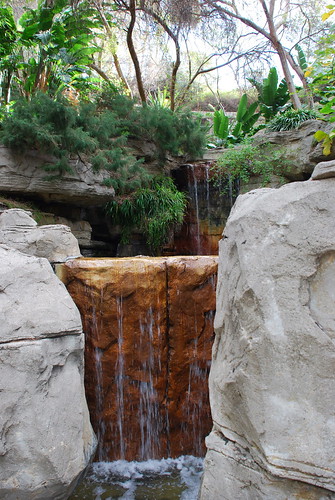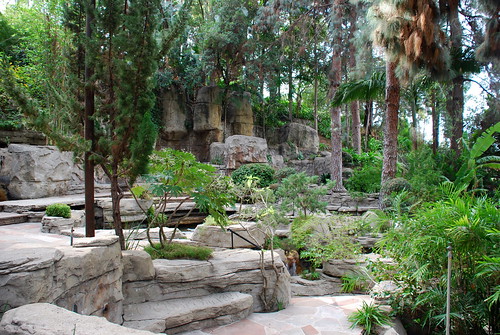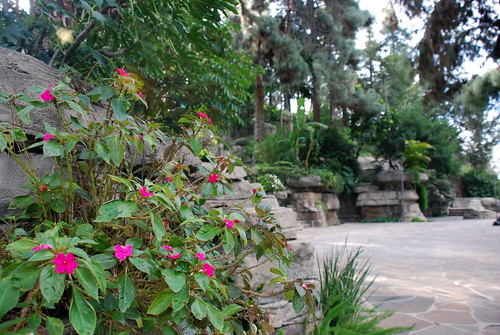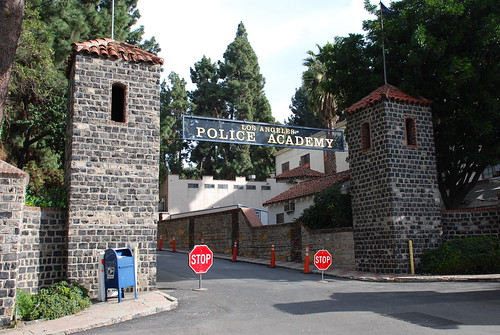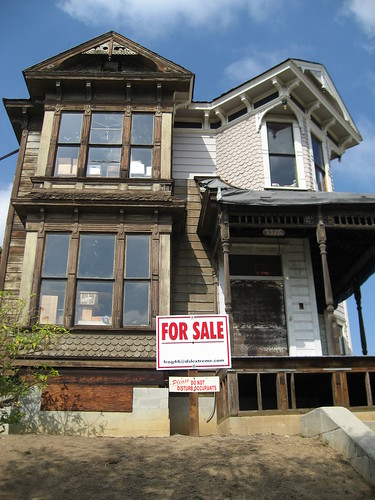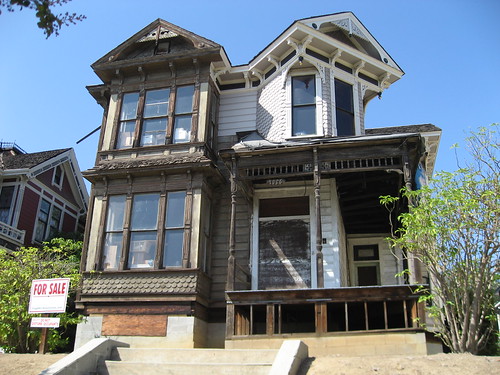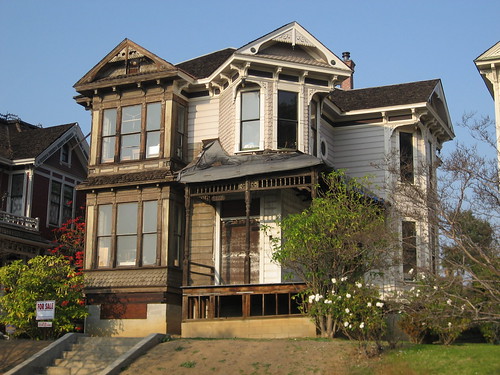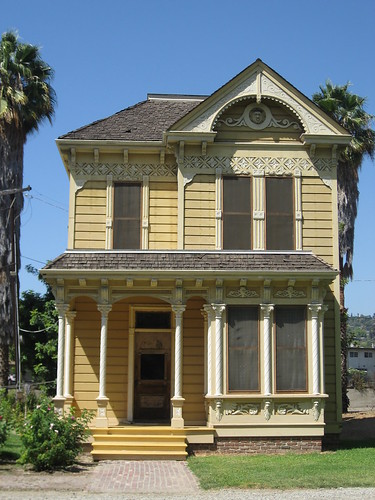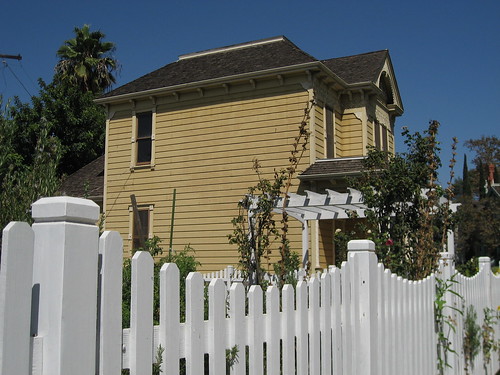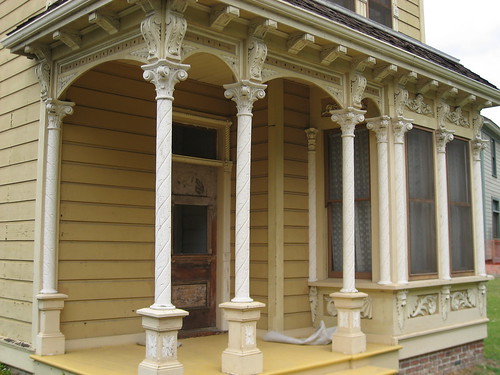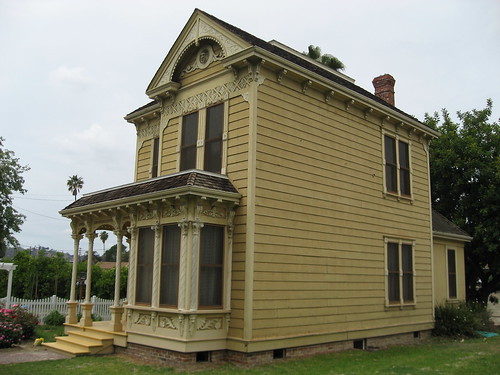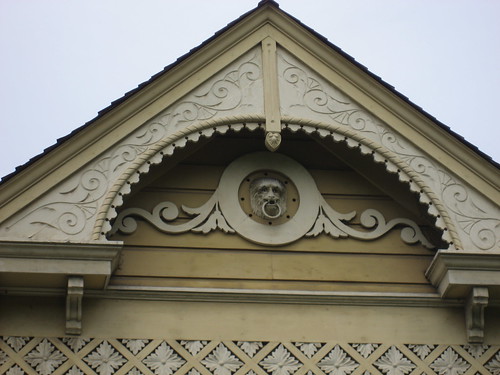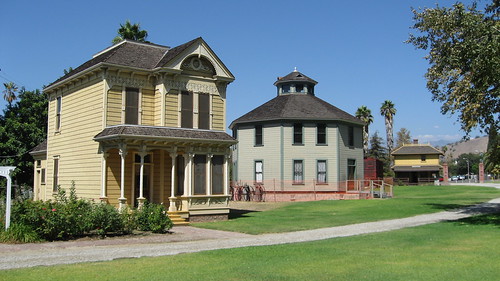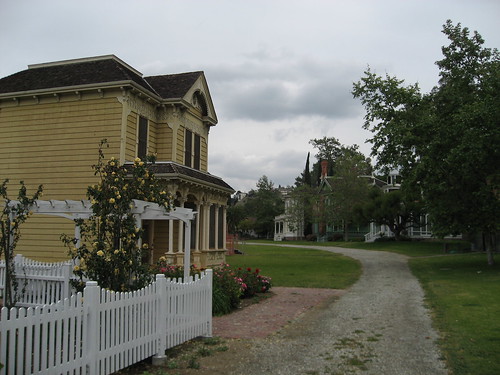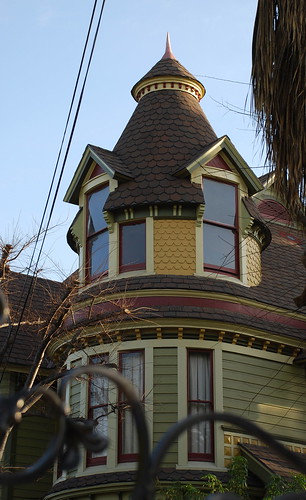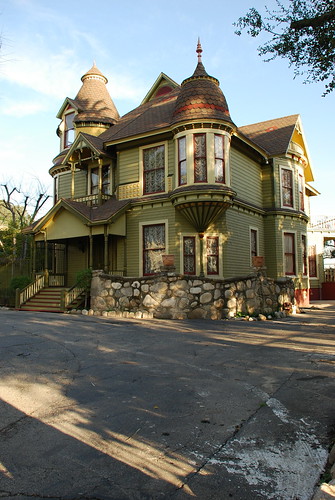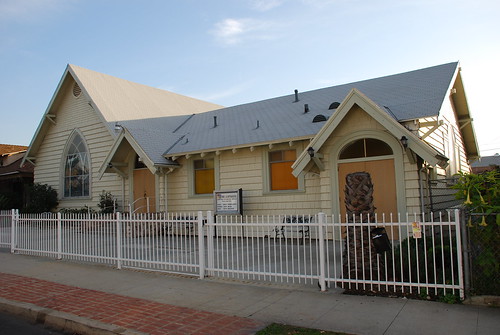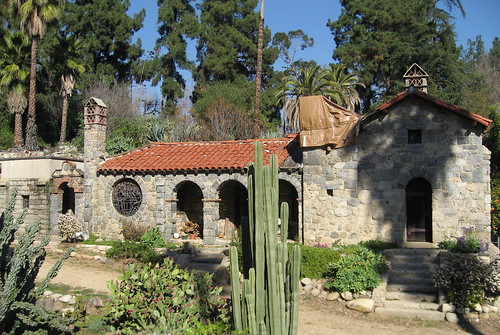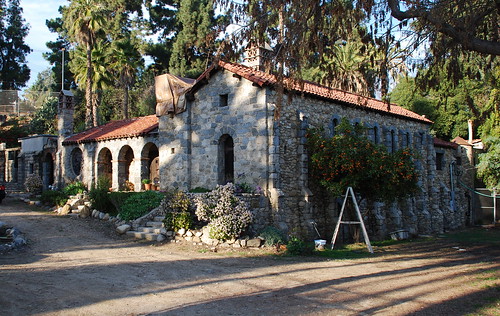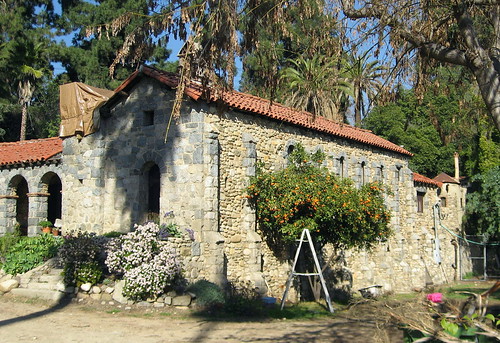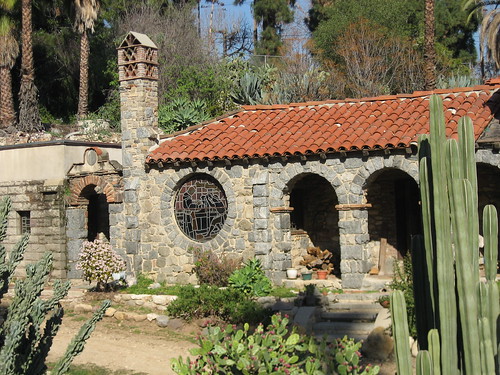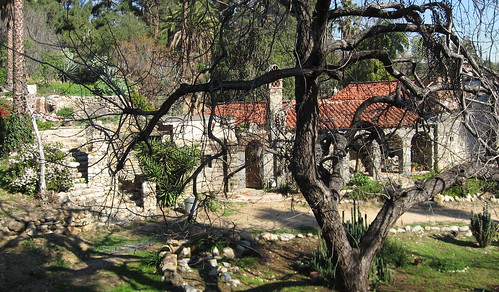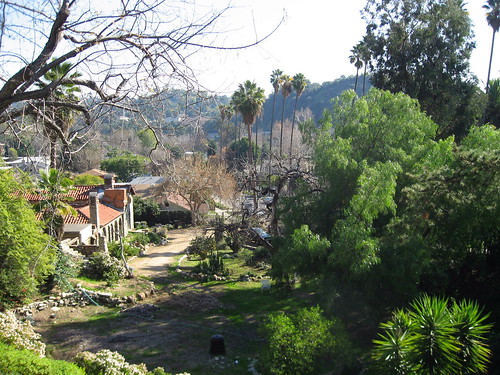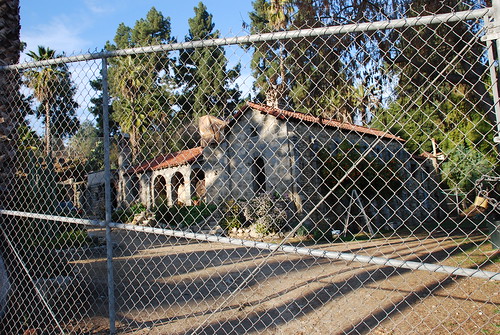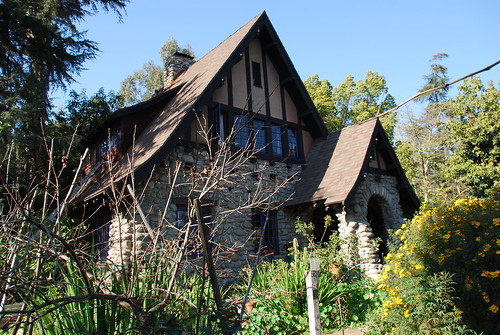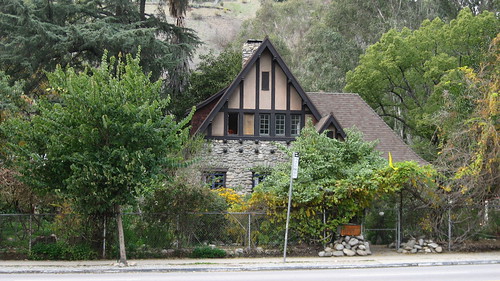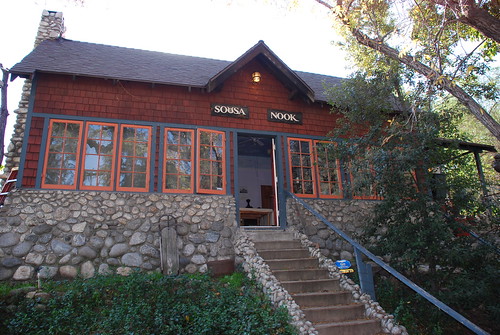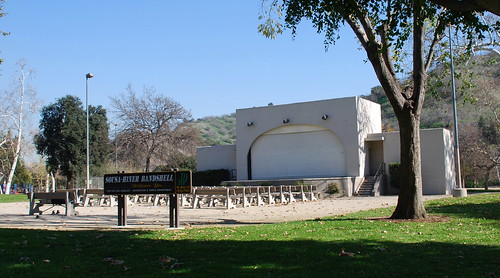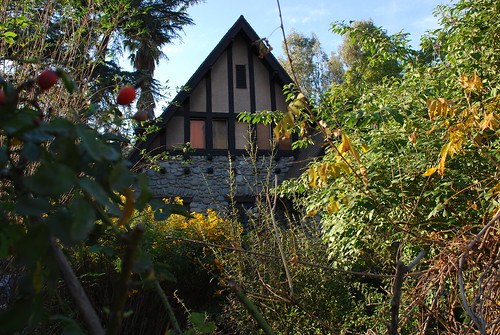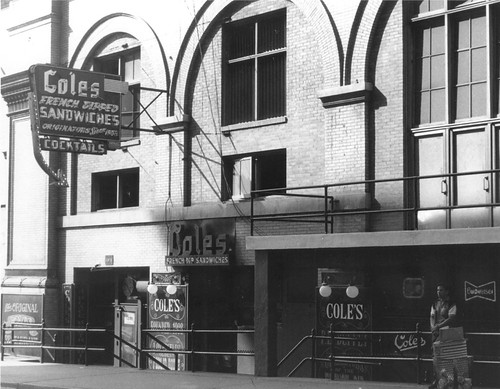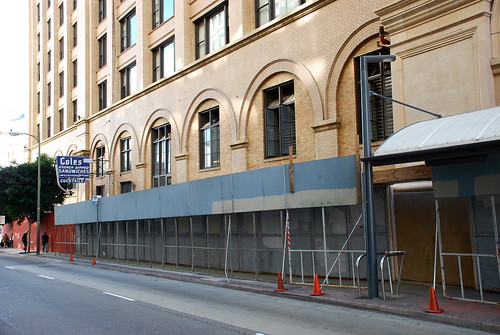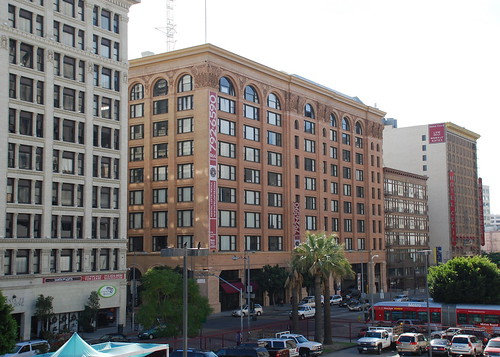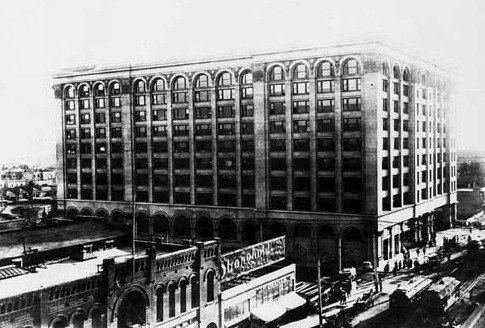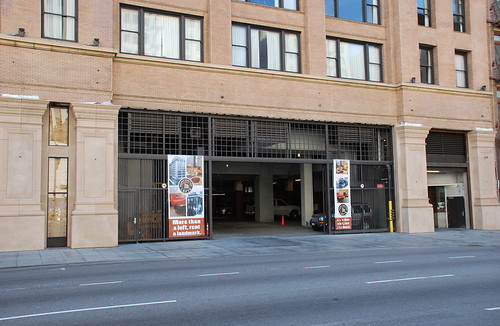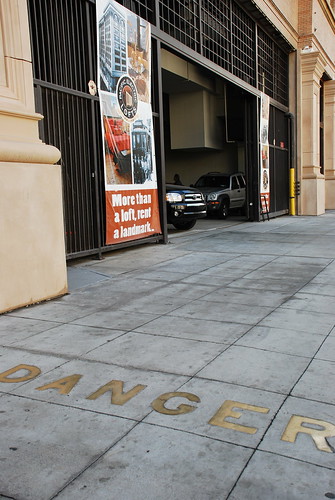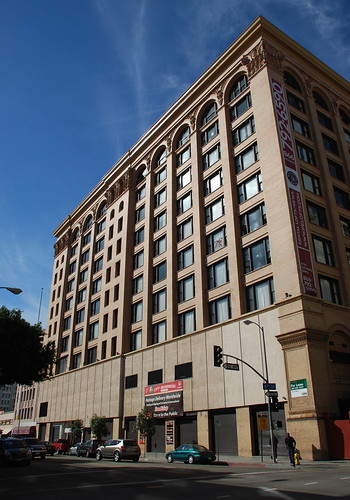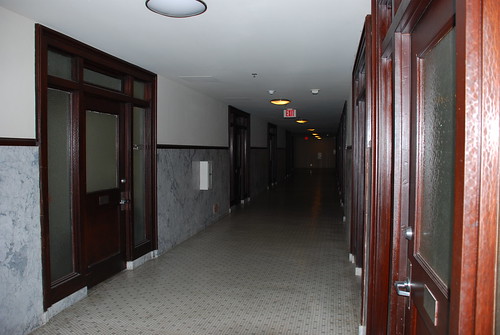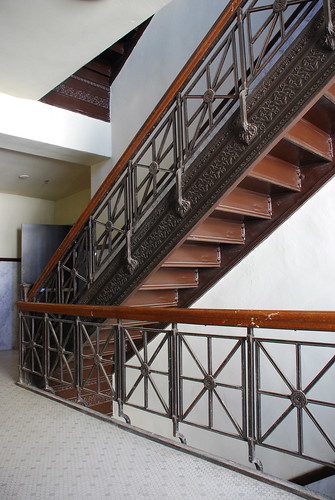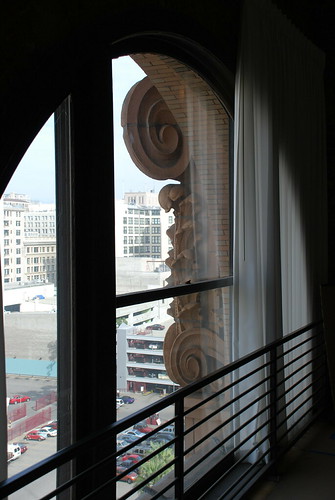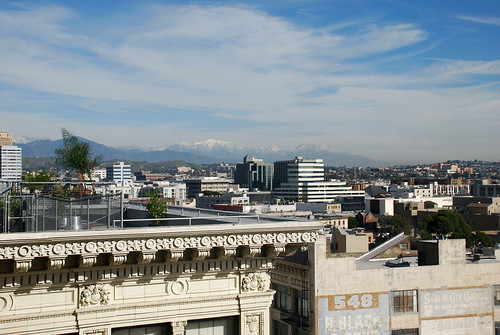Tuesday, January 29, 2008
No. 110 - Los Angeles Police Academy Rock Garden
Los Angeles Police Academy Rock Garden
1937 – Francois Scotti
1880 North Academy Drive, Elysian Park – map
Declared: 1/17/73
The Los Angeles Police Academy’s history in the Chavez Ravine area of Elysian Park goes back more than seventy-five years to when the Los Angeles Pistol Club was founded on more than twenty acres of leased city land. Today, that organization is the Los Angeles Police Revolver and Athletic Club.
Now, the Club’s website reports it was founded in 1931. The Los Angeles Police Department gives 1925. So, like I said, more than seventy-five years ago.
The Elysian Park shooting range served as the venue site for the 1932 Olympics revolver and pistol matches. Afterwards, the club acquired buildings and equipment from the U.S. Olympics Organizing Committee. The buildings had to be relocated from Olympic Village in Baldwin Hills.
The city took over training duties from LAPRAAC in 1936, with the LAPD officially moving in and maintaining the site since (the club is still there).
As for the city landmark, a year before the LAPD took over, the Parks Commission gave LAPRAAC the go-ahead to build an athletic center, including a rock garden, on the site. It wasn’t until early 1937 that the club hired landscape artist Francois Scotti to design the garden. He included four pools, stone seats, waterfalls, a modest amphitheater, and even a barbecue pit.
The Police Academy has been the site of many movie and teevee filmings. The Rock Garden, in particular, served as the setting for a couple of Tarzan movies (just look for the California pines in the deep, dark African jungles).
This city monument today can be rented for events, and is “the perfect place for Retirements, Reunions, and Weddings.”
If you would've visited the Rock Garden with me, not only would you be able to appreciate how beautiful the site is, but also you could tell me how high I'd leap out of my Buster Browns whenever there was a volley of gunfire from the adjacent shooting range. Funny stuff, there.
Up next : Hollywood Sign
continue reading...
Posted by
Floyd B. Bariscale
at
10:58 PM
15
comments
![]()
Saturday, January 26, 2008
No. 109 - Irey House
Irey House
1887
1325 Carroll Avenue – map
Declared: 1/3/73
For Sale: One Victorian fixer-upper in Angelino Heights, four bedrooms, five baths, formal dining room, two parlors, an office, and an attic. Mainly Eastlake in style with a bit of Stick thrown in.
Built in 1887, the house is named for it original owner, gardener Hiram B. Irey. At the time of its historic designation in 1973, the Irey House was still standing at 1123 Court Street near Boylston.
A few sources I’ve looked at mention the asymmetrical roof and window alignment. The Carroll Avenue Association’s Picture Album of Historic Angelino Heights from 1987 also notes a second-story window that lights up the interior stairwell.
Thanks to the Foundation’s efforts, the house was moved the seven blocks from Court Street in March, 1978, to its current site. Also moved from Court Street at that time was the house today found next door at 1321 Carroll, Monument No. 176. Both homes sit on a large lot occupied by a Victorian home torn down in 1970 (its estimated repair cost of $6,000 was too steep). Thanks to the Los Angeles Public Library and photographer Peter Antheil, here’s a picture of the old 1321 Carroll Avenue home.
It’s good to know both homes, hard-worn and graffitied, were donated by owners LAACO Inc. and William and Marilyn Soukesian to the Foundation. (The Carroll Avenue Restoration Foundation was begun in 1975 with four families on the block donating $350 each.)
The Irey home’s first owner on Carroll Avenue was Mr Don Pease.
The semi-restored house has been for sale at least since the first time I visited the block for Big Orange Landmarks, and the price has changed. Last March, the cost was listed at $1,600,000. By August, though, the price had gone up to $1,750,000. When I stopped by to take a few more pictures recently, there weren’t any sales flyers available, so I’m not sure what’s being asked as of today. If you go by, let us know.
Source:
Joan Dektar “Future Brightens for Old Houses” Los Angeles Times; Mar 26, 1978
Up next: Los Angeles Police Academy Rock Garden
continue reading...
Posted by
Floyd B. Bariscale
at
9:21 PM
4
comments
![]()
Wednesday, January 23, 2008
No. 108 - Beaudry Avenue House
Beaudry Avenue House
c. 1885
3800 Homer Avenue – map
Declared – 1/3/73
Heritage Square Museum calls this landmark the Ford House in recognition of its first owner, woodworker John J. Ford (his occupation would explain why the home’s woodcarving is especially ornate). A more popular name is the Beaudry Avenue House, as the structure was still standing at its original location at 140-142 North Beaudry Avenue, just northwest of Bunker Hill, when designated a city monument thirty-five years ago.
(Somewhat large parenthetical aside: Beaudry Avenue was named for Prudent Beaudry, “the first to popularize real estate and bring it within the reach of men of small means...” He was also a merchant, the first president of the Los Angeles City Water Company, a city councilman, Los Angeles mayor, co-owner of the Temple Street Cable Road, and originally from Quebec.)
Ford’s old home is a Victorian hodgepodge of Italianate, Queen Anne, and Eastlake styles. It was moved to Heritage Square a week before Thanksgiving in 1974. While the outside is well restored, the interior needs a lot work. Unfortunately for the Ford House, I think there are bigger priorities for the Museum to attack before the non-profit gets around to fixing up its inside.
1885 is the most common date I’ve seen for construction. The Museum uses 1887.
And, yes, these pictures were taken two different days, as with this shot of the Ford House with HCM No. 413, the Octagon House, and No. 22, the Palms-Southern Pacific Railroad Depot...
... and this one featuring the Ford House and HCM Nos 98, 40, and 65 (Mt Pleasant House, Hale House, and Valley Knudsen Garden Residence).
Up next: Irey House
continue reading...
Posted by
Floyd B. Bariscale
at
9:52 PM
2
comments
![]()
Labels: Northeast Los Angeles
Sunday, January 20, 2008
No. 107 - McClure House
McClure House
1889 – James H. Bradbeer
432 North Avenue 66, Garvanza – map
Declared: 11/15/72
Up until I visited Judson Studios last summer, I had no idea what a Garvanza was (other than a bean). Now it’s one of my favorite Los Angeles communities thanks, in part, to homes like this.
The Los Angeles’s Zoning and Map Access System, or ZIMAS, lists five buildings on the property, the oldest dating back to 1888. (ZIMAS also lets us know there are no oil wells on the land.) However, Gebhard and Winter’s Los Angeles: An Architectural Guide, reports the home was built in 1889 by architect James H. Bradbeer. More interestingly, the latter was the only source I found to call this Queen Anne/Eastlake home the McClure House.
A little digging around shows a William F. McClure living in Garvanza during the end of the 1800s. Among holding other occupations, McClure was a civil engineer, chief engineer of the Terminal and Crossroads, and a director of the Los Angeles and Raymond Railway. An L.A. Times article from November, 1887 included W.F. McClure on a list of Garvanzans who either had “residences under way or just finished”. (The same article also made note that Pasadena Avenue [now Figueroa] was soon to have cement sidewalks.)
If this was McClure’s house it saw a lot of parties, his wife being quite the hostess. In the early summer of 1890, Mrs McClure held a reception for newlyweds Charles and Dora Quein. "The spacious parlors were beautifully decorated with plants and flowers, and these together with the tasteful toilets of the ladies made a beautiful picture…" Later, "… a short but very enjoyable musical and literary programme was given, Mrs. McClure giving several selections in her own inimitable style…"
What the hell? Why would women take toilets to a wedding reception, tasteful or not?
That Mrs McClure must’ve been a riot. A few years later, she hosted a “Methodist social” in the house.
Rev. Mr. Hardie gave a very instructive talk on subjects suggested by pictures on the wall of what was very happily called the children’s room. B. Donnell favored the company with a recitation that was loudly applauded. The little folks sang two or three selections; their voices sounded very sweet, accompanied by Mrs. McClure on the guitar. And last but not least the dining-room with its profusion of roses and tables loaded with good things that were served in a dainty way by the hostess and her assistants.Mr McClure was absent. I wonder why.
So, just to be clear. I’m not positive this was the home of civil engineer W.F. McClure and his guitar-slinging wife. And, unfortunately, to do further research, I’d need to get up off my couch. So we’ve reached an impasse. In any event, the house looks in great shape – so great, in fact, I’m willing to overlook the front lawn being smothered in cement.
To make up for the ambivalent research on this post, here’s the nearby Garvanza Foursquare Church, also known as The Lighthouse, at 8408 Ruby Street. It’s not a city monument, but, having been built in 1908, the main building celebrates its centennial this year (another building on the lot was put up in 1895). (Oh, and there are no oil wells here, either.)
1/27/08 update: Jeffrey Herr, in his 2002 book, Landmark L.A: Historic-Cultural Monuments of Los Angeles, also names this the McClure House for W.F. McClure. Herr reports McClure was a director for the Garvanza Land Company. He also says the house is attributed to architect Joseph Cather Newsom, who did some work for the company. If that's so, then who was James H. Bradbeer?
Sources:
Skooteye. “Garvanza.” Los Angeles Times; Nov 5, 1887
“Note and Comment.” Los Angeles Times; Jun 29, 1890
“Social at Garvanza.” Los Angeles Times; Apr 23, 1892
Up next: Ford House
continue reading...
Posted by
Floyd B. Bariscale
at
9:04 PM
1 comments
![]()
Labels: Northeast Los Angeles
Thursday, January 17, 2008
No. 106 - Abbey San Encino
Abbey San Encino
1915 – Clyde Browne
6211 Arroyo Glen, Garvanza – map
Declared: 11/15/72
Okay. For starters. Abbey San Encino is A) not an abbey, and B) not in San Encino.
Printer/typographer Clyde Browne was born in Old Hickory, Ohio, in the summer of 1872. By the time he was twelve years old, his family had moved eight times, leapfrogging back and forth between Ohio, California, Missouri, and Kansas. It was in San Francisco when Clyde was about fifteen that he got a job on the Petaluma Imprint.
After serving as a cabin boy and apprentice sailor, Browne jumped ship in 1893 and headed back to Northern California where he worked for a series of newspapers around San Francisco. He also made a living for a while as a piano player in the Barbary Coast area.
Browne and his wife moved to Los Angeles around 1902/1903. In 1904, he went to work at the Los Angeles Examiner. He quit the paper four years later and, with Grace Wassum, his new wife (his first died in 1904), left his home around Fifth and Hill downtown, moving into a frame building on Figueroa (then named Pasadena Avenue). He quickly began renovating the house along with setting up a print shop, nicknamed “The Studio”, with Grace serving as a typesetter. It was Browne’s dream to form a sort of artists’ collective in what was already an area filled with artists (Judson Studios and El Alisal are nearby).
In 1910, he co-founded the printing firm of Browne and Cartwright. That same year, he convinced both USC and Occidental College to launch their own newspapers, a daily for the former (what became The Daily Trojan) and a weekly for the latter. Browne remained Occidental’s unofficial printer for more than thirty years.
Inspired by Elbert Hubbard’s Roycrofters, Browne moved a garage on his land and, in the summer of 1915, began the decade-long project of building his home, Abbey San Encino.
Browne modeled the home on a variety of places, like the Mary Queen of Scots Chapel at Holyrood Castle, the San Francisco de Solano Mission at Sonoma, and Carmel's San Carlos Borromeo Mission. He built a narrow gauge railway to carry stone from the nearby Arroyo Seco, and used odds and ends – nails, bolts, ship lanterns, iron, lumber, hinges, crucifixes, etc. – from ruined buildings across Europe. While continuing to write poems and plays and running his printing business, Browne scavenged granite blocks from a demolished building on Grand, sheet metal from old cars, bricks from a poultry yard, an abandoned brickyard, and the Mission San Gabriel, and bells from an elementary school, a Southern Pacific locomotive, and a fire engine. Much of the home’s stained glass came from the Van Nuys Hotel, closing its doors when Prohibition hit. While the majority of the work was finished by 1921, it wasn’t until July of 1924 when the family moved in.
Clyde Browne built much of the Abbey himself, originally calling the home “The Studio”, and then “The Old Stone Abbey” which evolved into “”Oldestane Abbey”. Upon a friend’s suggestion, he eventually settled on “Abbey San Encino”.
Browne loved all things medieval, and this shows in the building’s cellar, dungeons, refectory, and chapel, the last in which were held many weddings, often with Browne playing organ.
The big, round stained-glass window on the building’s south side depicts a Franciscan printer along with an American Indian boy working a handpress. Local tile maker Ernest Batchelder designed the Abbey’s fireplace. Later, several other stone buildings were put up on the property to serve as artist studios.
In 1934, Browne was Chairman of the Democratic Committee, and he ran for State Assembly. Clyde Browne died on July 1, 1942. His shop was closed up, the printing equipment sold.
Unless he’s sold the property and I didn’t get the newsletter, Abbey San Encino is owned by Edward Severin Browne, Clyde’s grandson. Severin’s brother, Clyde Jackson Browne, who, along with Severin, grew up in the Abbey, had a brief cameo in a 2003 episode of The Simpsons. Today, the land is pretty well fenced-off, but you can still see the home okay from the Arroyo Glen side.
A great big thanks to Michael Thompson of Michael R. Thompson Booksellers, who shared with me his sole, reference copy of 1982’s Clyde Browne: His Abbey and His Press, written by D.W. Davies for Castle Press. (Not coincidentally, Castle Press being founded in 1931 out of Abbey San Encino.)
Up next: McClure House
continue reading...
Posted by
Floyd B. Bariscale
at
10:59 PM
24
comments
![]()
Labels: Northeast Los Angeles
Tuesday, January 15, 2008
No. 105 - Hiner House
Hiner House
1922 – Carl Boller
4757 North Figueroa Street, Highland Park – map
Declared: 11/15/72
From the street, there isn’t a whole lot to see of the Hiner House. Oh, the home’s there; it’s just the 86-year-old house is pretty well obstructed by trees, shrubs, vines, etc., making any clear view from beyond the pavement tough indeed.
Dr Edward M. Hiner was born in Paola, Kansas in 1872. Sometime after 1889, he took over Kansas City’s Third Regiment Band, later known as “Hiner’s Band”. The military band became very popular, eventually giving a couple of performances at the White House for President McKinley. Later, during World War I, Hiner organized the Seventh Regiment Band to entertain soldiers heading overseas.
While the cornet-playing Hiner made his living as a Kansas City dentist in the 1890s, by the time he moved to Los Angeles in 1919, he had been running his band school in downtown K.C.
Upon arriving in L.A., Hiner opened what would soon become the largest private band school in the country, a distinction it held until his death in 1948. Dr. Hiner also founded the music department at Los Angeles Normal School, now UCLA.
In 1922, Hiner built this home on North Figueroa Street in Highland Park. Architect Carl Boller designed the house in a California Chalet style with some Stone Tudor and bit of Oriental influence thrown in for good measure (don’t ask me where the Oriental parts are).
Here's a picture from the city's Department of Planning website, showing a bit more of the building.
Hiner was good pals with John Philip Sousa, so much so Sousa even dedicated one of his tunes to Anna Hiner, Edward’s wife. The March King visited the Hiners a few times, and it’s for him the “Sousa Nook” is named. The “Sousa Nook” is the building, constructed in 1928 a few dozen yards south of the main home, in which Hiner had his music studio/rehearsal hall and gave lessons (although Hiner was known to hold practice in the backyard, as well).
The "Sousa Nook".
In 1953, Hiner’s widow, Anna, donated his collection of more than 6,000 band scores to the Kansas City Public Library.
Across the street from the Hiner House stands Sycamore Grove Park. Nearly all state picnic concerts performed there starting on July 30, 1922 – the year his home was put up – were conducted by Hiner. In 2005, at the initiation of the Highland Park Heritage Trust, the city named the stage in the park the Sousa-Hiner Bandshell.
What places the Hiner House stop among my very, very favorite visits, yet, is that I got the pleasure of meeting the current owners. The graciously offered me the chance not only to see the inside of this great old home, but also to take a look around the property, helping me take a few shots I never would’ve been able to get from the pavement.
The couple bought the property from a Hiner descendant back in 1995, making them just the second family of the house. This, along with the fact they themselves are preserving and restoring the house, accounts for why the home is in such good shape. In fact, window trim was being restored and painted while I was there. And, man, if you heard the details of the work and care (and money) put into restoring the exterior woodwork alone, you’d know the home was in good hands.
Thanks very much, Heather and Troy, for your time. It was as nice meeting you both as it was the landmark.
Finally, for main sources, special thanks to Dory DeAngelo’s Hiner biography on the Kansas City Public Library website and the November 12, 2005 press release from City Councilmember Ed P. Reyes dedicating the Sousa-Hiner Bandshell.
Up next: San Encino Abbey
continue reading...
Posted by
Floyd B. Bariscale
at
11:08 PM
4
comments
![]()
Labels: Northeast Los Angeles
Saturday, January 12, 2008
No. 104 - Cole's P.E. Buffet/Pacific Electric Building
Cole’s P.E. Buffet/Pacific Electric Building
1908 (Cole’s)
118 East Sixth Street – map
Declared: 10/18/72
1903 – Thornton Fitzhugh (building)
610 South Main – map
Declared: 10/17/89
Like Los Angeles Historic-Cultural Monument No. 103, No. 104 is split up into two different parts (at least, this time, they’re on the same site). The first, declared a monument back in 1972, is Cole’s P.E. Buffet, located on the ground floor of what was once the Pacific Electric Building. In 1989, the Cultural Heritage Commission amended its seventeen-year-old designation to include the building itself.
From L.A.'s Department of City Planning website.
Harry/Henry Cole founded his restaurant/saloon in 1908. Besides running the restaurant, Cole also offered the city’s first check-cashing service from the bar. In addition to the longevity, one of Cole’s claims to fame is that the French dipped sandwich was invented here. That could be the case, just don’t tell these people.
Today, Cole’s stands as the oldest continuously-operated restaurant in Los Angeles. Well, continuously operating when it is being operated, that is. The restaurant closed for renovations last March, shortly after being bought by downtown real estate developer Cedd Moses. Now, since the original HCM designation is supposed to protect Cole’s interior, we’ll have to wait and see how much of the inside – including the mahogany bar, Tiffany lampshades, and tables made of old railway cars (none of which I know was still around as of last March, yet was there at one point) – is changed when Moses reopens Cole’s, hopefully in time for its centennial celebration.
Hey, Cedd, what’s the latest?
LATimeMachines.com has a nice picture of the interior of Cole’s here.
Now, for the Pacific Electric Building.
The history of the Pacific Electric Railway Company can – and does – fill books. The "Floyd’s Notes" version goes like this:
Henry Huntington took over Eli Clark and Moses Sherman’s interurban rail line, incorporating the Pacific Electric Railway Company in the fall of 1901. Basically, it was Huntington’s intention to use the service as a way to sell real estate more than anything else.
Architect Thornton Fitzhugh was hired to design a massive terminal building at the corner of Sixth and Main Streets. Originally called the Huntington Building, here’s a picture of it under construction. (At least one man, 24-year-old iron worker Russell Morehouse, was killed during construction, falling from the fourth story.)
When the $1.7 million terminal opened January 12, 1905 (103 years ago today!), it was the biggest building in the west. Looking at the picture above, you can see how it dwarfs its neighbors (but it wouldn't for long.) Here’s what the Los Angeles Times had to say the day after the big opening:
Undoubtedly the handsomest trolley railroad station in the United States, that of the Pacific Electric is the Huntington Building, at Sixth and Main streets, was opened yesterday for the first time. All cars from Pasadena, Monrovia, Alhambra and San Gabriel on the northern division, Long Beach and other points on the southern division were run into the building. The traffic was handled without a hitch, and the automatic trolley turner worked to perfection. This device is the invention of chief Electrician Horace Anderson and his assistants, who have arranged many improvements in electrical appliances, fitting them to the particular needs of the Pacific Electric Railroad.
There used to be Yellow Cars and Red Cars, the former pretty much sticking to downtown, the latter traveling all over the place. For those of us less than, say, fifty years old, we can only imagine what it was like to ride streetcars from San Bernardino to Long Beach or San Fernando Valley to San Gabriel Valley for a handful of change.
Huntington sold out to the Southern Pacific in 1911 at which time the P.E. was consolidated with more than half a dozen other railway companies.
Here's the entrance to the old train shed, now the way to get into the parking lot for the Pacific Electric Lofts.
While the corporation eventually spread to four counties on more than 1,000 miles of track and became the world’s largest interurban railway (in 1923, the Red Cars carried more than 109 million riders), the Pacific Electric Railway was never a hugely profitable venture (it lost $2.8 million in 1919 alone).
"Hey! Look out! You're about to be hit by a streetcar!"
Until 1925, the Pacific Electric Building was also home to the Jonathan Club, occupying its top three floors. Restored today is the club’s rotunda on the eighth floor, now a library/lounge for residents of the Pacific Electric Lofts (more on them below). The old Jonathan Club ballroom on the ninth floor has been converted into three large loft units. (Here's a lousy picture of the rotunda today. And this is the wonderfully restored mosaic artwork in the rotunda.)
An old shopfront to the right of the former train shed entrance.
Bus service in and out of the Pacific Electric Building was introduced at the start of World War II and lasted for more than twenty years.
In 1944, Claude Beelman redesigned the building’s lobby in more of a Streamline style. Today, the lobby is renovated not so much in the original design but rather Beelman’s.
This is the back - the Los Angeles Street - side of the P.E. Building. Hopefully future restoration will include the opening up of the old arches hidden by, er, that stuff hiding the old arches. For a view of the other side of those old windows - now a parking garage - click here.
A day after the official last passenger trip of the Red Cars on April 8, 1961, the Electric Railway Historical Association chartered a two-car train from Long Beach to the P.E. Building and back as one last hurrah to end the Long Beach line. Freight continued to be moved on the Pacific Electric line for about four more years.
The rooftop garden.
Another view from the P.E. Building.
Since the summer of 2005, the old Huntington Building has been home to the Pacific Electric Lofts. You need to check out their website, as there’s a bit of history and even some interactive stuff available.
In November the Los Angeles Conservancy held a Mainly Main walking tour, in which a handful of landmarks on Main Street, including the P.E. Building, opened their doors for tour groups. I took a bunch of pictures inside HCM No. 104 that day (none was allowed on the ninth floor), but even the best (shown here) was pretty terrible. If the Conservancy gives you the opportunity to see the inside of the building again, take it.
Here's one final shot, taken from a window on one floor or another.
“Great Depot Open” Los Angeles Times; Jan 13, 1905
“Two Fearful Falls, Two Men Killed.” Los Angeles Times; Sep 10, 1903
Robert M. Fogelson The Fragmented Metropolis University of California Press 1967 Berkeley, Los Angeles, London
Spencer Crump Ride the Big Red Cars Trans-Anglo Books 1970 Costa Mesa, CA
Up next: Hiner House
continue reading...
Posted by
Floyd B. Bariscale
at
10:11 PM
4
comments
![]()
Labels: Central City
Subscribe to:
Posts (Atom)



